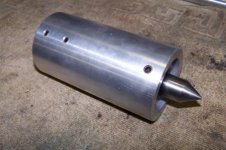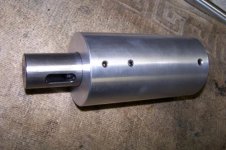M
Moldmaker
Guest
I have a larger lathe(Nardini 1640) and the head stock it a bit long for building an outboard support.
I'm looking for some input from guys here that have already invented this wheel.
I plan on putting on a 6 jaw Buck chuck, but want to know a few things that you guys are doing.
1) I normally work on tapered barrels(Tactical rifles). For barrel threading, I was thinking of making a sleeve out of Alum, tapered to the barrel contour, and then slotting it so the chuck will clamp the barrel tight when mounting.(Will need to remove action for this). The only issue is if the outside of the tube is not concentric, it could offset the thread. we put suppressors on so the barrel needs to be pretty close to the bore alignment. Input on this?
2)Cambering with a long lathe headstock. Im concerned the same issue as above, if chucking up on the chamber end, I have no real good way to adjust the barrel if it is out of line too much.
Any input is appreciated..just looking to save some headache and barrel blanks,lol..
I'm looking for some input from guys here that have already invented this wheel.
I plan on putting on a 6 jaw Buck chuck, but want to know a few things that you guys are doing.
1) I normally work on tapered barrels(Tactical rifles). For barrel threading, I was thinking of making a sleeve out of Alum, tapered to the barrel contour, and then slotting it so the chuck will clamp the barrel tight when mounting.(Will need to remove action for this). The only issue is if the outside of the tube is not concentric, it could offset the thread. we put suppressors on so the barrel needs to be pretty close to the bore alignment. Input on this?
2)Cambering with a long lathe headstock. Im concerned the same issue as above, if chucking up on the chamber end, I have no real good way to adjust the barrel if it is out of line too much.
Any input is appreciated..just looking to save some headache and barrel blanks,lol..








